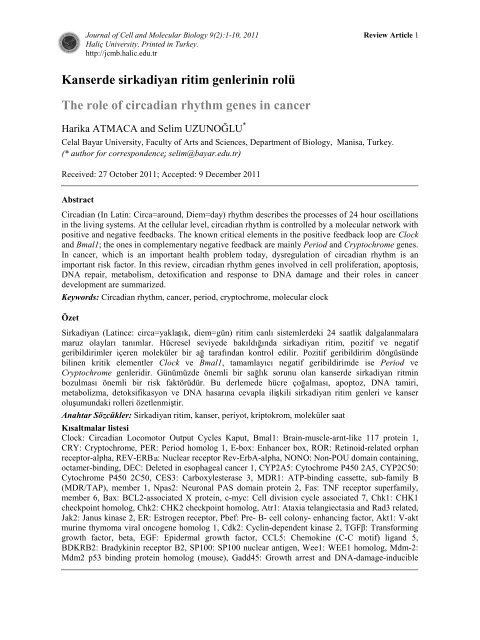Journal of Cell and Molecular Biology - ResearchGate
Journal of Cell and Molecular Biology - ResearchGate
Journal of Cell and Molecular Biology - ResearchGate
Create successful ePaper yourself
Turn your PDF publications into a flip-book with our unique Google optimized e-Paper software.
<strong>Journal</strong> <strong>of</strong> <strong>Cell</strong> <strong>and</strong> <strong>Molecular</strong> <strong>Biology</strong> 9(2):1-10, 2011 Review Article 1<br />
Haliç University, Printed in Turkey.<br />
http://jcmb.halic.edu.tr<br />
Kanserde sirkadiyan ritim genlerinin rolü<br />
The role <strong>of</strong> circadian rhythm genes in cancer<br />
Harika ATMACA <strong>and</strong> Selim UZUNOĞLU *<br />
Celal Bayar University, Faculty <strong>of</strong> Arts <strong>and</strong> Sciences, Department <strong>of</strong> <strong>Biology</strong>, Manisa, Turkey.<br />
(* author for correspondenceselim@bayar.edu.tr)<br />
Received: 27 October 2011; Accepted: 9 December 2011<br />
Abstract<br />
Circadian (In Latin: Circa=around, Diem=day) rhythm describes the processes <strong>of</strong> 24 hour oscillations<br />
in the living systems. At the cellular level, circadian rhythm is controlled by a molecular network with<br />
positive <strong>and</strong> negative feedbacks. The known critical elements in the positive feedback loop are Clock<br />
<strong>and</strong> Bmal1; the ones in complementary negative feedback are mainly Period <strong>and</strong> Cryptochrome genes.<br />
In cancer, which is an important health problem today, dysregulation <strong>of</strong> circadian rhythm is an<br />
important risk factor. In this review, circadian rhythm genes involved in cell proliferation, apoptosis,<br />
DNA repair, metabolism, detoxification <strong>and</strong> response to DNA damage <strong>and</strong> their roles in cancer<br />
development are summarized.<br />
Keywords: Circadian rhythm, cancer, period, cryptochrome, molecular clock<br />
Özet<br />
Sirkadiyan (Latince: circa=yaklaşık, diem=gün) ritim canlı sistemlerdeki 24 saatlik dalgalanmalara<br />
maruz olayları tanımlar. Hücresel seviyede bakıldığında sirkadiyan ritim, pozitif ve negatif<br />
geribildirimler içeren moleküler ağ bir tarafından kontrol edilir. Pozitif geribildirim döngüsünde<br />
bilinen kritik elementler Clock ve Bmal1, tamamlayıcı negatif geribildirimde ise Period ve<br />
Cryptochrome genleridir. Günümüzde önemli bir sağlık sorunu olan kanserde sirkadiyan ritmin<br />
bozulması önemli bir risk faktörüdür. Bu derlemede hücre çoğalması, apoptoz, DNA tamiri,<br />
metabolizma, detoksifikasyon ve DNA hasarına cevapla ilişkili sirkadiyan ritim genleri ve kanser<br />
oluşumundaki rolleri özetlenmiştir.<br />
Anahtar Sözcükler: Sirkadiyan ritim, kanser, periyot, kriptokrom, moleküler saat<br />
Kısaltmalar listesi<br />
Clock: Circadian Locomotor Output Cycles Kaput, Bmal1: Brain-muscle-arnt-like 117 protein 1,<br />
CRY: Cryptochrome, PER: Period homolog 1, E-box: Enhancer box, ROR: Retinoid-related orphan<br />
receptor-alpha, REV-ERBα: Nuclear receptor Rev-ErbA-alpha, NONO: Non-POU domain containing,<br />
octamer-binding, DEC: Deleted in esophageal cancer 1, CYP2A5: Cytochrome P450 2A5, CYP2C50:<br />
Cytochrome P450 2C50, CES3: Carboxylesterase 3, MDR1: ATP-binding cassette, sub-family B<br />
(MDR/TAP), member 1, Npas2: Neuronal PAS domain protein 2, Fas: TNF receptor superfamily,<br />
member 6, Bax: BCL2-associated X protein, c-myc: <strong>Cell</strong> division cycle associated 7, Chk1: CHK1<br />
checkpoint homolog, Chk2: CHK2 checkpoint homolog, Atr1: Ataxia telangiectasia <strong>and</strong> Rad3 related,<br />
Jak2: Janus kinase 2, ER: Estrogen receptor, Pbef: Pre- B- cell colony- enhancing factor, Akt1: V-akt<br />
murine thymoma viral oncogene homolog 1, Cdk2: Cyclin-dependent kinase 2, TGFβ: Transforming<br />
growth factor, beta, EGF: Epidermal growth factor, CCL5: Chemokine (C-C motif) lig<strong>and</strong> 5,<br />
BDKRB2: Bradykinin receptor B2, SP100: SP100 nuclear antigen, Wee1: WEE1 homolog, Mdm-2:<br />
Mdm2 p53 binding protein homolog (mouse), Gadd45: Growth arrest <strong>and</strong> DNA-damage-inducible

















